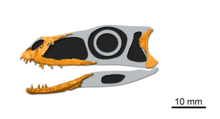Maehary: Difference between revisions
Guarani languageGuarani languagevkhjwbfhdebrf |
|||
| Line 13: | Line 13: | ||
== Discovery and naming == |
== Discovery and naming == |
||
The ''Maehary'' [[holotype]] specimen, '''CAPPA/UFSM 0300''', was discovered in layers of the Caturrita Formation. The specimen was originally described in 2010 as a fossil of of the supposed basal pterosaur ''[[Faxinalipterus]]''. However, when the latter genus was reinterpreted as a lagerpetid in 2022, the snout was removed from its [[hypodigm]] and given its own genus and species, ''Maehary bonapartei''. The holotype consists of a partial skull, vertebral centra, and fragmentary [[scapula]]. '''UFRGS-PV-0769-T''', a referred specimen consisting of a left maxilla, was previously referred to ''[[Faxinalipterus]]''. |
The ''Maehary'' [[holotype]] specimen, '''CAPPA/UFSM 0300''', was discovered in layers of the Caturrita Formation. The specimen was originally described in 2010 as a fossil of of the supposed basal pterosaur ''[[Faxinalipterus]]''.<ref>J. F. Bonaparte, C. L. Schultz, and M. B. Soares. (2010). Pterosauria from the Late Triassic of southern Brazil. In S. Bandyopadhyay (ed.), ''New Aspects of Mesozoic Biodiversity, Lecture Notes in Earth Sciences'' 132:63-71.</ref> However, when the latter genus was reinterpreted as a lagerpetid in 2022, the snout was removed from its [[hypodigm]] and given its own genus and species, ''Maehary bonapartei''. The holotype consists of a partial skull, vertebral centra, and fragmentary [[scapula]]. '''UFRGS-PV-0769-T''', a referred specimen consisting of a left maxilla, was previously referred to ''[[Faxinalipterus]]''. |
||
In 2022, Kellner ''et al''. described Marhary as a new genus and species of pterosauromorph. The [[Genus|generic name]], "''Maehary''" is derived from the [[Guarani-Kaiowá|Guarani-Kaiowa]] phrase "Ma’ehary", roughly translating to "who looks to the sky", in reference to the pterosauromorph affinities of the taxon. The [[Specific name (zoology)|specific name]], "''bonapartei''", honors the Argentine paleontologist [[José Bonaparte|José F. Bonaparte]] |
In 2022, Kellner ''et al''. described Marhary as a new genus and species of pterosauromorph. The [[Genus|generic name]], "''Maehary''" is derived from the [[Guarani-Kaiowá|Guarani-Kaiowa]] phrase "Ma’ehary", roughly translating to "who looks to the sky", in reference to the pterosauromorph affinities of the taxon. The [[Specific name (zoology)|specific name]], "''bonapartei''", honors the Argentine paleontologist [[José Bonaparte|José F. Bonaparte]] |
||
Revision as of 16:58, 9 May 2022
| Maehary | |
|---|---|

| |
| Holotype skull | |
| Scientific classification | |
| Domain: | Eukaryota |
| Kingdom: | Animalia |
| Phylum: | Chordata |
| Class: | Reptilia |
| Clade: | Archosauria |
| Clade: | Pseudosuchia |
| Family: | †Gracilisuchidae (?) |
| Genus: | †Maehary Kellner et al., 2022 |
| Species: | †M. bonapartei
|
| Binomial name | |
| †Maehary bonapartei Kellner et al., 2022
| |
Maehary (meaning "one who looks to the sky" in Guaraní) is a genus of pterosauromorph from the Late Triassic (Norian) Caturrita Formation of Rio Grande do Sul, Brazil. The genus contains a single species, M. bonapartei, known from a partial skull.[1]
Discovery and naming
The Maehary holotype specimen, CAPPA/UFSM 0300, was discovered in layers of the Caturrita Formation. The specimen was originally described in 2010 as a fossil of of the supposed basal pterosaur Faxinalipterus.[2] However, when the latter genus was reinterpreted as a lagerpetid in 2022, the snout was removed from its hypodigm and given its own genus and species, Maehary bonapartei. The holotype consists of a partial skull, vertebral centra, and fragmentary scapula. UFRGS-PV-0769-T, a referred specimen consisting of a left maxilla, was previously referred to Faxinalipterus.
In 2022, Kellner et al. described Marhary as a new genus and species of pterosauromorph. The generic name, "Maehary" is derived from the Guarani-Kaiowa phrase "Ma’ehary", roughly translating to "who looks to the sky", in reference to the pterosauromorph affinities of the taxon. The specific name, "bonapartei", honors the Argentine paleontologist José F. Bonaparte
Classification
Kellner et al. (2022) recovered Maehary as the earliest diverging member of Pterosauromorpha. The results of their phylogenetic analysis are shown below:
| Pterosauromorpha |
| ||||||
References
- ^ Kellner, A.W.A.; Holgado, B.; Grillo, O.; Pretto, F.A.; Kerber, L.; Pinheiro, F.L.; Soares, M.B.; Schultz, C.L.; Lopes, R.T.; Araújo, A.; Müller, R.T. (2022). "Reassessment of Faxinalipterus minimus, a purported Triassic pterosaur from southern Brazil with the description of a new taxon". PeerJ. 10: e13276. doi:10.7717/peerj.13276.
- ^ J. F. Bonaparte, C. L. Schultz, and M. B. Soares. (2010). Pterosauria from the Late Triassic of southern Brazil. In S. Bandyopadhyay (ed.), New Aspects of Mesozoic Biodiversity, Lecture Notes in Earth Sciences 132:63-71.













